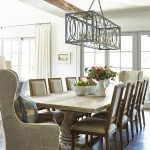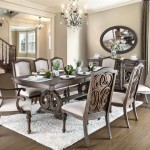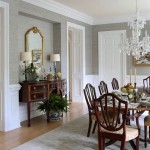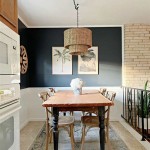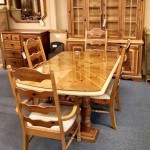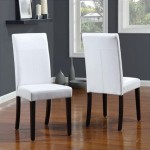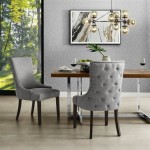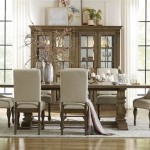```html
Home Interior Design: Transforming Your Dining Room
The dining room, traditionally a space dedicated to meals, has evolved into a multi-functional area in modern homes. It serves as a place for family gatherings, informal meetings, and even a temporary workspace. Therefore, effective home interior design for the dining room must consider both aesthetics and functionality. This article explores key aspects of dining room design, providing insights into creating a comfortable, stylish, and practical space.
Defining the Dining Room's Purpose and Style
Before embarking on any design changes, it is crucial to define the primary purpose of the dining room. Is it solely for formal dinners, or will it be used for everyday meals, homework sessions, and game nights? The answers to these questions will heavily influence the selection of furniture, lighting, and overall layout. For instance, a dining room primarily used for formal dinners might benefit from a grand chandelier and elegant dining set, while a multi-functional space requires durable surfaces, comfortable seating, and ample storage solutions.
Style is another defining factor. Common dining room styles include traditional, contemporary, modern, rustic, and bohemian. Traditional dining rooms often feature rich wood tones, ornate details, and classic furniture designs. Contemporary dining rooms embrace clean lines, neutral colors, and minimalist decor. Modern dining rooms prioritize functionality and sleek aesthetics, often incorporating metal and glass elements. Rustic dining rooms evoke a sense of warmth and nature, utilizing natural materials like wood and stone. Bohemian dining rooms are characterized by eclectic mixes of patterns, textures, and colors, creating a relaxed and informal atmosphere. Selecting a style that complements the overall home decor and personal preferences is essential for a cohesive and visually appealing design.
Consider the existing architectural features of the room. High ceilings may call for dramatic lighting fixtures, while a small space might benefit from light colors and mirrored surfaces to create an illusion of spaciousness. Natural light is a valuable asset, so ensure windows are not obstructed and consider sheer curtains or blinds to filter sunlight.
Essential Elements: Furniture, Lighting, and Decor
The dining room furniture typically includes a dining table, chairs, and storage pieces like sideboards or buffets. The size and shape of the dining table should be proportional to the room's dimensions and the number of people typically seated. Rectangular tables are versatile and suitable for both formal and informal settings. Round tables promote conversation and are ideal for smaller groups. Square tables work well in compact spaces. Material selection is also important. Wood is a classic choice, offering durability and warmth. Glass tabletops create a modern and airy feel. Metal legs add a touch of industrial chic.
Chairs should be comfortable and ergonomically designed, especially if the dining room is used for extended periods. Upholstered chairs provide extra comfort, while wooden chairs offer a more formal look. Mixing and matching chairs can add visual interest and personality to the dining room. Consider the chair height in relation to the table height to ensure comfortable seating. Sideboards and buffets provide storage for tableware, linens, and serving dishes. They also serve as a display surface for decorative items. Choose storage pieces that complement the dining table and chairs in terms of style and material.
Lighting plays a crucial role in setting the mood and highlighting the dining room's features. A combination of ambient, task, and accent lighting is recommended. Ambient lighting provides overall illumination, typically achieved through a chandelier or pendant light suspended above the dining table. Task lighting focuses on specific areas, such as a sideboard or reading nook. Accent lighting highlights artwork or architectural details. Dimmers allow for adjusting the light intensity to create different atmospheres. Choose light fixtures that complement the style of the dining room and provide adequate illumination for all activities.
Decorating the dining room involves adding personal touches that reflect the homeowners' taste and style. Artwork, mirrors, plants, and decorative objects can enhance the visual appeal of the space. A large piece of artwork can serve as a focal point, while mirrors can create an illusion of spaciousness. Plants add a touch of nature and freshness to the dining room. Table linens, such as tablecloths, runners, and placemats, can add color and texture to the table setting. Centerpieces, such as floral arrangements or candle displays, can create a festive atmosphere. Choose decor items that complement the overall style of the dining room and avoid cluttering the space.
Optimizing Space and Functionality
Space optimization is particularly important in smaller dining rooms. Strategic furniture placement and clever storage solutions can maximize the usable space. Wall-mounted shelves and cabinets provide storage without taking up floor space. A dining table with drop-leaf extensions can be adjusted to accommodate different numbers of guests. Mirrors can create an illusion of spaciousness and reflect light, making the room feel brighter and larger.
Functionality should be a paramount consideration. In a multi-functional dining room, consider incorporating features that support various activities. A built-in desk or workstation can transform the dining room into a temporary office. Comfortable seating and good lighting can create a relaxing reading nook. Storage solutions for games, books, and other items can keep the space organized and clutter-free. Choosing durable and easy-to-clean materials is also essential, especially if the dining room is used for everyday meals and activities.
Consider the flow of traffic within the dining room. Ensure there is enough space for people to move around the table and access storage areas without obstruction. A rug can define the dining area and add warmth and texture to the space. However, the rug should be large enough to accommodate all the chairs when they are pulled out from the table. Proper ventilation is also crucial, especially if the dining room is located near the kitchen. A ceiling fan or window can help circulate air and prevent the space from becoming stuffy.
Accessibility is another important factor to consider, especially for individuals with mobility issues. Ensure there is enough space for wheelchairs or walkers to maneuver around the table and access seating. Choose chairs with armrests to provide support for getting in and out of the chair. Avoid using rugs with thick piles that can be difficult to navigate. Consider installing grab bars in the bathroom if it is located near the dining room.
By carefully considering these aspects of home interior design, it is possible to transform a dining room into a functional, stylish, and welcoming space that enhances the overall living experience.
```
Dining Room Design Interior Designcafe

80 Elevated Dining Room Ideas Perfect For Entertaining In 2025

Top 15 Classic Dining Room Design Ideas 2025

Six Dining Room Interior Design And Decor Ideas

30 Dining Room Ideas For A Glamorous And Contemporary Home

97 Dining Rooms Ideas In 2025 Room House Interior

Dining Room Interior Design Idea By Dlife Home Interiors

Top 15 Classic Dining Room Design Ideas 2025

How To Design A One Of Kind Dining Room For Your Family Friends Beautiful Homes

Different Dining Room Style Ideas For Your Home Designcafe
See Also

